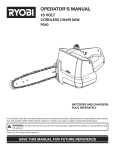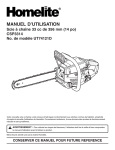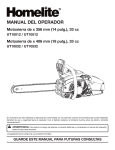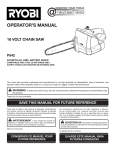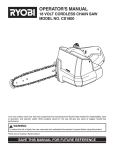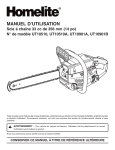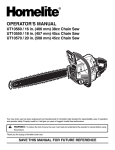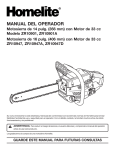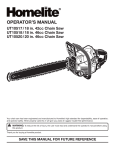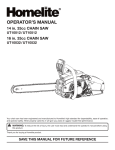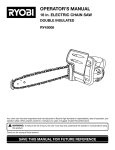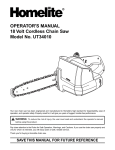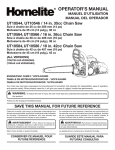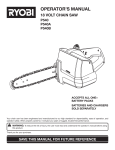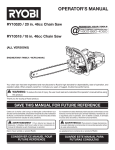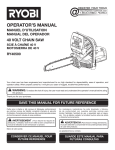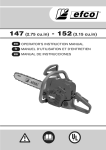Download Homelite UT10510 User's Manual
Transcript
OPERATOR'S MANUAL 14 in. (356 mm) 33cc Chain Saw Model No. UT10510 Your new chain saw has been engineered and manufactured to Homelite’s high standard for dependability, ease of operation, and operator safety. Properly cared for, it will give you years of rugged, trouble-free performance. WARNING: To reduce the risk of injury, the user must read and understand the operator’s manual before using this product. Thank you for buying a Homelite chain saw. SAVE THIS MANUAL FOR FUTURE REFERENCE TABLE OF CONTENTS ■ Introduction ..................................................................................................................................................................... 2 ■ General Safety Rules .................................................................................................................................................. 3-4 ■ Specific Safety Rules ................................................................................................................................................... 4-5 ■ Symbols .......................................................................................................................................................................... 6 ■ Specifications ................................................................................................................................................................. 7 ■ Features ......................................................................................................................................................................... 8 ■ Operation ................................................................................................................................................................... 9-21 ■ Maintenance ............................................................................................................................................................ 22-32 ■ Bar and Chain Combination .......................................................................................................................................... 33 ■ Troubleshooting ....................................................................................................................................................... 33-34 ■ Warranty ....................................................................................................................................................................... 35 ■ Parts Ordering/Service ................................................................................................................................................. 36 INTRODUCTION IMPORTANT Servicing requires extreme care and knowledge and should be performed only by a qualified service technician. When servicing use only identical Homelite replacement parts. For safe operation, read and understand all instructions before using the chain saw. Follow all safety instructions. Failure to follow all safety instructions listed below, may result in serious personal injury. WARNING: Carefully read through this entire operator's manual before using your new saw. Pay close attention to the Safety Rules and all Safety Alert Symbols including Danger, Warning, and Caution. These safety rules are for your safety and to prevent possible serious injury. If you use your saw properly and only for what it is intended, you will enjoy years of safe, reliable service. Look for this symbol to point out important safety precautions. It means attention!!! Your safety is involved. WARNING: The operation of any power tool can result in foreign objects being thrown into your eyes, which can result in severe eye damage. Before beginning tool operation, always wear safety goggles or safety glasses with side shields and a full face shield when needed. We recommend Wide Vision Safety Mask for use over eyeglasses or standard safety glasses with side shields. Always wear eye protection which is marked to comply with ANSI Z87.1. Page 2 GENERAL SAFETY RULES ■ DO NOT OPERATE A CHAIN SAW WITH ONE HAND. Serious injury to the operator, helpers, bystanders, or any combination of these persons may result from one-handed operation. A chain saw is intended for two-handed use. WARNING: The warnings, labels, and instructions found in this section of the operator's manual are for your safety. Failure to follow all instructions may result in serious personal injury. Safe operation of this tool requires that you read and understand this operator's manual and all labels affixed to the tool. Safety is a combination of using common sense, staying alert, and knowing how your saw works. READ ALL INSTRUCTIONS ■ KICKBACK MAY OCCUR WHEN THE NOSE OR TIP OF THE GUIDE BAR touches an object or when the wood closes in and pinches the saw chain in the cut. Tip contact in some cases may cause a lightning-fast reverse reaction kicking the guide bar up and back toward the operator. Pinching the saw chain along the top of the guide bar may push the guide bar rapidly back toward the operator. Either of these reactions may cause you to lose control of the saw which could result in serious personal injury. DO NOT rely exclusively upon the safety devices built into your saw. As a chain saw user, you should take several steps to keep your cutting jobs free from accident or injury. 1. With a basic understanding of kickback, you can reduce or eliminate the element of surprise. Sudden surprise contributes to accidents. 2. Keep a good firm grip on the saw with both hands when the engine is running. Place your right hand on the rear handle and your left hand on the front handle with your thumbs and fingers encircling the chain saw handles. A firm grip together with a stiff left arm will help you maintain control of the saw if kickback occurs. ■ DO NOT ALLOW OTHER PERSONS to be near the chain saw when starting or cutting with the chain saw. Keep bystanders and animals out of the work area. ■ DO NOT START CUTTING until you have a clear work area, secure footing, and a planned retreat path from the falling tree. ■ KEEP ALL PARTS OF YOUR BODY away from the saw chain when the engine is running. ■ ALWAYS CARRY THE CHAIN SAW WITH THE ENGINE STOPPED AND THE BRAKE ENGAGED, the guide bar and saw chain to the rear, and the muffler away from your body. When transporting the chain saw, use the appropriate guide bar scabbard. ■ DO NOT OPERATE A CHAIN SAW THAT IS DAMAGED, improperly adjusted, or not completely and securely assembled. Be sure that the saw chain stops moving when the throttle control trigger is released. ■ USE EXTREME CAUTION when cutting small-size brush and saplings because slender material may catch the saw chain and be whipped toward you or pull you off balance. 4. Cut at high engine speeds. Always cut with the engine running at full speed. Fully squeeze the throttle trigger and maintain a steady cutting speed. 7. Only use replacement bars and chains specified by the manufacturer or the equivalent. ■ USE CAUTION WHEN HANDLING FUEL. Move the chain saw at least 30 feet (9 m) from the fueling point before starting the engine. ■ SHUT OFF THE ENGINE before setting the chain saw down. DO NOT leave the engine running unattended. 3. Make sure that the area in which you are cutting is free from obstructions. DO NOT let the nose of the guide bar contact a log, branch, fence, or any other obstruction that could be hit while you are operating the saw. 6. Follow the manufacturer's sharpening and maintenance instructions for the saw chain. ■ USE SAFETY FOOTWEAR. Wear snug-fitting clothing, protective gloves, and eye, hearing, and head protection devices. ■ DO NOT STAND ON ANY UNSTABLE SURFACE while using your chain saw, that includes ladders, scaffolds, trees, etc. ■ KNOW YOUR TOOL. Read the operator's manual carefully. Learn the saw's applications and limitations as well as the specific potential hazards related to this tool. 5. Do not overreach or cut above chest height. ■ DO NOT OPERATE A CHAIN SAW WHEN YOU ARE FATIGUED. Never operate a chain saw when you are tired or under the influence of medication, drugs, or alcohol. ■ WHEN CUTTING A LIMB that is under tension, be alert for springback so that you will not be struck when the tension in the wood fibers is released. ■ KEEP THE HANDLES dry, clean, and free of oil or fuel mixture. ■ OPERATE THE CHAIN SAW ONLY in well-ventilated areas. ■ DO NOT OPERATE A CHAIN SAW IN A TREE unless you have been specifically trained to do so. Page 3 GENERAL SAFETY RULES ■ ALL CHAIN SAW SERVICE, other than the items listed in the instruction manual and all maintenance, should be performed by competent chain saw service personnel. (For example, if improper tools are used to remove the flywheel or if an improper tool is used to hold the flywheel in order to remove the clutch, structural damage to the flywheel could occur and subsequently could cause the flywheel to burst.) ■ KEEP SAFE-T-TIP ANTI-KICKBACK NOSE GUARD properly mounted on the guide bar to prevent rotational kickback. ■ FOLLOW THE SHARPENING and maintenance instructions for the saw chain. ■ USE ONLY THE REPLACEMENT GUIDE BARS and low kickback chains specified for your saw. ■ DO NOT adapt your powerhead to a bow guide or use it to power any attachments or devices not listed for your saw. ■ SAVE THESE INSTRUCTIONS. Refer to them frequently and use to instruct other users. If you loan someone this tool, loan them these instructions also. SPECIFIC SAFETY RULES ■ Wear eye protection which is marked to comply with ANSI Z87.1, as well as, hearing and head protection when operating this equipment. WARNING: The warnings, labels, and instructions found in this section of the operator's manual are for your safety. Failure to follow all instructions may result in serious personal injury. REFUELING (DO NOT SMOKE!) ■ To reduce the risk of fire and burn injury, handle fuel with care. It is highly flammable. ■ Mix and store fuel in a container approved for gasoline. GENERAL PRECAUTIONS ■ DO NOT CUT VINES and/or small underbrush (less than 3 in./76 mm in diameter). ■ MUFFLER SURFACES ARE VERY HOT during and after operation of the chain saw; keep all body parts away from the muffler. Serious burns may occur if contact is made with the muffler. ■ Always hold the chain saw with both hands when the engine is running. Use a firm grip with thumbs and fingers encircling the chain saw handles. ■ Never let anyone use your chain saw who has not received adequate instructions in its proper use. This applies to rentals as well as privately owned saws. ■ Before you start the engine, make sure the saw chain is not contacting any object. ■ Operate the chain saw only in well ventilated areas. SAFETY APPAREL ■ Wear snug fitting clothing. Always wear heavy, long pants, boots, and gloves. Do not wear jewelry, short pants, sandals, or go barefoot. Do not wear loose fitting clothing, which could be drawn into the engine or catch the chain or underbrush. Wear overalls, jeans, or chaps made of cut resistant material or ones that contain cut resistant inserts. Secure hair so that it is above shoulder level. ■ Wear non-slip safety footwear and heavy-duty gloves to improve your grip and to protect your hands. ■ Mix fuel outdoors where there are no sparks or flames. ■ Select bare ground, stop the engine, and allow it to cool before refueling. ■ Loosen the fuel cap slowly to release pressure and to keep fuel from escaping around the cap. ■ Tighten the fuel cap securely after refueling. ■ Wipe spilled fuel from the unit. Move 30 feet (9 m) away from refueling site before starting engine. ■ Never attempt to burn off spilled fuel under any circumstances. BASIC PRECAUTIONS IN THE CUTTING/ WORK AREA ■ Do not operate a chain saw in a tree. ■ Do not cut from a ladder, this is extremely dangerous. ■ Keep bystanders and animals out of the work area. Do not allow other persons to be nearby during starting or cutting with the chain saw. Note: The size of the work area depends on the job being performed as well as the size tree or workpiece involved. For example, felling a tree requires a larger work area than making other cuts (i.e., bucking cuts, etc.). Page 4 SPECIFIC SAFETY RULES PUSH AND PULL MAINTENANCE PRECAUTIONS See Figure 1. The reaction force is always opposite to the direction the chain is moving. Thus, the operator must be ready to control the PULL when cutting on the bottom edge of the bar and the PUSH when cutting along the top edge. Never operate a chain saw that is damaged, improperly adjusted, or is not completely and securely assembled. Be sure that the saw chain stops moving when the throttle control trigger is released. If the saw chain moves at idle speed, the carburetor may need adjusting. Refer to “Operation” later in this manual. If the saw chain still moves at idle speed after adjustment has been made, contact a Homelite Service Center for adjustment and discontinue use until the repair is made. WARNING: All chain saw service, other than items in the operator's manual maintenance instructions, should be performed by competent chain saw service personnel. If improper tools are used to remove the flywheel or clutch, or if an improper tool is used to hold the flywheel in order to remove the clutch, structural damage to the flywheel could occur which could subsequently cause the flywheel to burst and serious injury could result. PULL KICKBACK PUSH Fig. 1 Kickback is a dangerous reaction that can lead to serious injury. Do not rely only on the safety devices provided with your saw. As a chain saw user, you must take special safety precautions to help keep your cutting jobs free from accident or injury. Note: See the "Operation" section later in this manual for added information on kickback and how to avoid serious personal injury. Note: Your chain saw has been fully factory tested. It is normal to find some slight oil residue on the saw. Page 5 SYMBOLS Important: Some of the following symbols may be used on your tool. Please study them and learn their meaning. Proper interpretation of these symbols will allow you to operate the tool better and safer. SYMBOL NAME EXPLANATION Safety Alert Symbol Indicates danger, warning or caution. It means attention!!! Your safety is involved. Read Your Operator’s Manual Your manual contains special messages to bring attention to potential safety concerns, machine damage as well as helpful operating and servicing information. Please read all the information carefully to avoid injury and machine damage. Eye, Hearing, and Head Protection Wear eye, hearing, and head protection when operating this equipment. SAFE-T-TIP Nose Guard The SAFE-T-TIP nose guard on the guide bar helps prevent kickback. No Smoking No smoking, sparks, or open flame. Prohibited Symbol Diagonal line across a symbol means this is prohibited or should be avoided. Hold and operate the saw properly with both hands. Operate with Two Hands One Handed Do not operate the saw using only one hand. Carbon Monoxide Engines produce carbon monoxide which is an odorless, deadly poison. Do not operate in an enclosed area. Kickback Danger – beware of kickback. Bar Nose Contact Avoid bar nose contact. Gloves Wear non-slip gloves. Page 6 SYMBOLS The purpose of safety symbols is to attract your attention to possible dangers. The safety symbols, and the explanations with them, deserve your careful attention and understanding. The safety warnings do not by themselves eliminate any danger. The instructions or warnings they give are not substitutes for proper accident prevention measures. Symbol Meaning DANGER: Indicates an imminently hazardous situation which, if not avoided, will result in death or serious injury. WARNING: Indicates a potentially hazardous situation which, if not avoided, could result in death or serious injury. CAUTION: Indicates a potentially hazardous situation which, if not avoided, may result in minor or moderate injury. CAUTION: (Without Safety Alert Symbol) Indicates a situation that may result in property damage. SAVE THESE INSTRUCTIONS SPECIFICATIONS Weight - No bar, chain, fuel or oil ........................................................................................................... 9.7 lbs. (4.4 kg) Fuel tank volume .................................................................................................................................... 19.4 oz. (575 ml) Chain oil tank volume ............................................................................................................................. 11.8 oz. (350 ml) Bar lengths ............................................................................................................................................... 14 in. (356 mm) Chain pitch .............................................................................................................................................. .375 in (9.5 mm) Chain gauge ......................................................................................................................................... .050 in. (1.25 mm) Chain type ....................................................................................................................................................... Low Profile Drive sprocket ........................................................................................................................................................ 6-tooth Engine displacement .................................................................................................................................. 2.0 in.3 (33 ml) Maximum engine power (ISO 7293) .................................................................................................... 1.78HP (1.33 kW) Idle engine speed ................................................................................................................................ 2,600 - 3,400 RPM Fuel tank capacity .................................................................................................................................. 19.4 oz. (575 ml) Oil tank capacity ..................................................................................................................................... 11.8 oz. (350 ml) Page 7 FEATURES TRIGGER RELEASE THROTTLE LOCK BUTTON CHAIN OIL CAP FRONT HAND GUARD SAFE-T-TIP BAR MOUNTING NUTS CHOKE LEVER PRIMER BULB FRONT HANDLE CLUTCH COVER CYLINDER COVER STARTER GRIP REAR HANDLE STARTER/FAN HOUSING STOP IGNITION SWITCH FUEL CAP THROTTLE TRIGGER Fig. 2 Page 8 OPERATION GUIDE BARS WARNING: Generally, guide bars with small radius tips have somewhat lower kickback potentials. When making a replacement, be sure to order one of the Homelite bars listed for your saw in this operator's manual. The proper size SAFE-T-TIP nose guard comes installed on the bar. Use only guide bars that have a provision for mounting the SAFE-T-TIP. The warnings and instructions in this section of the operator's manual are for your safety and to prevent serious personal injury. UNDERSTANDING YOUR CHAIN SAW SAFETY DEVICES SAFE-T-TIP ANTI-KICKBACK NOSE GUARD WARNING: See Figure 3. The SAFE-T-TIP prevents kickback because it covers the tip of the bar where rotational kickback is generated. Inexperienced persons should never attempt to cut when the SAFE-T-TIP has been removed from the bar tip. SAFE-T-TIP Fig. 3 Users, such as professional loggers who need to draw the tip through the cut, make boring cuts, or cut logs bigger than the bar length, should reinstall the SAFE-T-TIP as soon as those cuts are complete. When cutting without the SAFE-T-TIP, the user must use proper techniques as shown in the manual to avoid kickback. Note: Refer to “Maintenance” later in this manual for instructions on reinstalling the SAFE-T-TIP nose guard. KICKBACK occurs when the moving chain contacts an object at the upper portion of the tip of the guide bar or when the wood closes in and pinches the saw chain in the cut. Contact at the upper portion of the tip of the guide bar can cause the chain to dig into the object and stop the chain for an instant. The result is a lightning fast, reverse reaction which kicks the guide bar up and back toward the operator. If the saw chain is pinched along the top of the guide bar, the guide bar can be driven rapidly back toward the operator. Either of these reactions can cause loss of saw control which can result in serious injury. Do not rely exclusively upon the safety devices built into your saw. As a chain saw user, you should take several steps to keep your cutting jobs free from accident or injury. LOW KICKBACK SAW CHAIN The rakers (depth gauges) ahead of each cutter can minimize the force of a kickback reaction by preventing the cutters from digging in too deeply at the kickback zone. Only use replacement chain that is equivalent to the original chain or has been certified as a low kickback chain. As saw chains are sharpened, they lose some of the low kickback qualities and extra caution is required. Page 9 OPERATION KICKBACK PRECAUTIONS See Figures 4 and 5. Rotational kickback occurs when the moving chain contacts an object at the Kickback Danger Zone of the guide bar. The result is a lightning fast, reverse reaction which kicks the guide bar up and back towards the operator. This reaction can cause loss of control which can result in serious injury. KICKBACK DANGER ZONE Fig. 4 ROTATIONAL KICKBACK immediately with clean water. If irritation is still present, see a doctor immediately. ■ Clean up spilled fuel immediately. MIXING THE FUEL ■ This product is powered by a 2-cycle engine and requires pre-mixing gasoline and 2-cycle oil. Pre-mix unleaded gasoline and 2-cycle engine oil in a clean container approved for gasoline. ■ This engine is certified to operate on unleaded gasoline intended for automotive use with an octane rating of 87 ([R + M] / 2) or higher. ■ Do not use any type of pre-mixed gasoline/oil from fuel service stations, this includes the pre-mixed gasoline/oil intended for use in mopeds, motorcycles, etc. ■ Use a high quality 2-cycle self-mixing oil for air-cooled engines. Do not use automotive oil or 2-cycle outboard oil. ■ Mix 2% oil into the gasoline. This is a 50:1 ratio. ■ Mix the fuel thoroughly and each time before fueling. ■ Mix in small quantities. Do not mix quantities larger than usable in a 30-day period. A 2-cycle oil containing a fuel stabilizer is recommended. 50:1 GAS Fig. 5 WARNING: Always shut off engine before fueling. Never add fuel to a machine with a running or hot engine. Move at least 30 ft. (9 m) from refueling site before starting the engine. DO NOT SMOKE! Failure to heed this warning can result in possible personal injury. FUEL AND REFUELING HANDLING THE FUEL SAFELY WARNING: OIL FUEL MIX FILLING THE TANK See Figure 6. Refer to “Specific Safety Rules – Refueling” earlier in this manual for additional safety information. 1. Clean the surface around fuel cap to prevent contamination. 2. Loosen the fuel cap slowly. 3. Carefully pour the fuel mixture into the tank. Avoid spillage. 4. Prior to replacing the fuel cap, clean and inspect the gasket. 5. Immediately replace the fuel cap and hand tighten. Wipe up any fuel spillage. Note: It is normal for the engine to emit smoke during and after the first use. Check for fuel leaks, if any are found, correct them before using the saw to prevent fire or burn injury. ■ ■ ■ ■ 50:1 GAS Always handle fuel with care, it is highly flammable. Always refuel outdoors and do not inhale fuel vapors. Do not let gasoline or oil come in contact with skin. Keep gasoline and oil away from the eyes. If gasoline or oil comes in contact with the eyes, wash them 1 Quart 2 Quart 3 Quart 4 Quart 5 Quart Page 10 OIL + + + + + .67 oz. 1.35 oz. 2.0 oz. 2.7 oz. 3.38 oz. FUEL MIX = = = = = } 50:1 OPERATION STARTING THE ENGINE See Figures 8 through 14. WARNING: STOP Keep your body to the left of the chain line. Never straddle the saw or chain, or lean over past the chain line. Fig. 6 ADDING OIL 1. Place the chain saw on level ground and ensure that no objects or obstructions are in immediate vicinity that could come in contact with the bar and chain. 2. Hold the front handle firmly with the left hand and put your right foot onto the base of the rear handle. See Figure 7. Use HOMELITE Bar and Chain Oil. It is designed for chains and chain oilers, and is formulated to perform over a wide temperature range with no dilution required. Chain saw should use approximately one tank of oil per tank of fuel. Note: Do not use dirty, used or otherwise contaminated oils. Damage may occur to the oil pump, bar, or chain. 1. Carefully pour the bar and chain oil into the tank. 2. Fill the oil tank every time you fuel the engine. Fig. 8 IGNITION SWITCH IN THE RUN POSITION STOP P STO Fig. 9 PRIMER BULB Fig. 7 Fig. 10 Page 11 OPERATION STARTING THE ENGINE: 3. 4. 5. 6. STARTER GRIP Set the ignition switch to the RUN (I) position. Fully press and release the PRIMER BULB 7 times. Pull CHOKE lever all the way OUT to full position. While squeezing both the trigger release and throttle trigger, push in the throttle lock button. Release the throttle trigger. This latches the trigger for starting. Fig. 13 TRIGGER RELEASE CHOKE LEVER FULL CHOKE STOP HALF CHOKE RUN POSITION THROTTLE TRIGGER Fig. 11 TRIGGER RELEASE STOP THROTTLE LOCK BUTTON THROTTLE TRIGGER Fig. 12 Page 12 Fig. 14 OPERATION 7. When the temperature is above 50° F, pull the STARTER GRIP until the engine attempts to start, but no more than 3 times. When the temperature is below 50° F, pull the STARTER GRIP until the engine attempts to start, but no more than 5 times. 8. Push CHOKE lever to half choke position. 9. Pull STARTER GRIP until engine runs. Note: Allow the saw to run in this position 15-30 seconds depending upon the temperature. 10. Push CHOKE lever all the way IN. 11. SQUEEZE and release the throttle trigger to return the engine to idle. Now you are ready to pick up the saw. Use the proper grip for both handles, refer to “Operation” for additional information. STOPPING THE ENGINE See Figure 15. Release the throttle trigger and let the engine return to idle. To stop the engine, move the ignition switch to the ” stop position. Do not put the chain saw on the “ ground when the chain is still moving. If the ignition switch will not stop the saw when set to the stop “ ” position, have the ignition switch repaired before using the chain saw again to prevent unsafe conditions or serious injury. Important: When you are finished using the saw, relieve tank pressures by loosening the CHAIN OIL and FUEL MIX caps. Then retighten the caps. Allow the engine to cool before storing. IGNITION SWITCH IN THE STOP POSITION STOP STOP Fig. 15 Page 13 OPERATION PREPARING FOR CUTTING PROPER GRIP ON HANDLES See Figures 16 and 17. Refer to “Specific Safety Rules – Safety Apparel” earlier in this manual for appropriate safety equipment. ■ Wear non-slip gloves for maximum grip and protection. ■ Hold the saw firmly with both hands. Always keep your LEFT HAND on the front handle and your RIGHT HAND on the rear handle so that your body is to the left of the chain line. WARNING: Never use a left-handed (cross-handed) grip or any stance that would place your body or arm across the chain line. CHAIN LINE WARNING: DO NOT operate the throttle trigger with your left hand and hold the front handle with your right hand. Never allow any part of your body to be in the chain line while operating a saw. PROPER CUTTING STANCE ■ Maintain a proper grip on the saw whenever the engine is running. The fingers should encircle the handle and the thumb is wrapped under the handlebar. This grip is least likely to be broken (by a kickback or other sudden reaction of the saw). Any grip in which the thumb and fingers are on the same side of the handle is dangerous because a slight kick of the saw can cause loss of control. See Figure 18. ■ Balance your weight with both feet on solid ground. ■ Keep left arm with elbow locked in a “straight arm” position to withstand any kickback force. ■ Keep your body to the left of the chain line. ■ Keep your thumb on underside of handlebar. THUMB ON UNDERSIDE OF HANDLE BAR CHAIN LINE STRAIGHT ARM Fig. 16 PROPER GRIP Fig. 18 Fig. 17 Page 14 OPERATION BASIC OPERATING/CUTTING PROCEDURES Practice cutting a few small logs using the following technique to get the “feel” of using your saw before you begin a major sawing operation. 1. Take the proper stance in front of the wood with the saw idling. 2. Accelerate the engine to full throttle just before entering the cut by squeezing the throttle trigger. 3. Begin cutting with the saw against the log. 4. Keep the engine at full throttle the entire time you are cutting. 5. Allow the chain to cut for you; exert only light downward pressure. Forcing the cut could result in damage to the bar, chain, or engine. 6. Release the throttle trigger as soon as the cut is completed allowing the engine to idle. Running the saw at full throttle without a cutting load can result in unnecessary wear to the chain, bar, and engine. 7. Do not put pressure on the saw at the end of the cut. ■ Do not fell trees near electrical wires or buildings. Leave this operation for professionals. ■ Cut only when visibility and light are adequate for you to see clearly. ADJUSTING THE CARBURETOR See Figures 20 and 21. Before adjusting the carburetor, clean the air filter and the starter cover vents. Allow the engine to warm up prior to carburetor adjustment. Refer to “Maintenance” later in this manual. AIR FILTER WORK AREA PRECAUTIONS See Figure 19. ■ Cut only wood or materials made from wood; no sheet metal, no plastics, no masonry, no non-wood building materials. ■ Never allow children to operate your saw. Allow no person to use this chain saw who has not read this operator's manual or received adequate instructions for the safe and proper use of this chain saw. ■ Keep everyone – helpers, bystanders, children, and animals, a SAFE DISTANCE from the cutting area. During felling operations, the safe distance should be a least twice the height of the largest trees in the felling area. During bucking operations, keep a minimum distance of 15 feet (4.5m) between workers. Fig. 20 STOP STOP STARTER COVER VENTS Fig. 21 The carburetor is factory set and should not require adjusting. The carburetor will permit only limited adjustment of the “L” (Low Jet) and “H” (High Jet) needles. Any adjustment should be done by a Homelite Service Center. Under no circumstances should the “L” (Low Jet) and “H” (High Jet) needles be forced outside the range of adjustment. CAUTION: Fig. 19 ■ Always cut with both feet on solid ground to prevent being pulled off balance. ■ Do not cut above chest height as a saw held higher is difficult to control against kickback forces. Serious damage can occur to the engine if improper adjustments are made to the “L” and “H” needles. Do not force the “L” and “H” needles outside the adjustment range! Page 15 OPERATION ADJUSTING IDLE SPEED FELLING TREES ■ If the engine starts, runs, and accelerates but will not idle, turn the idle speed screw “ T ” clockwise to increase idle speed. ■ If the chain turns at idle, turn the idle speed screw “ T ” counterclockwise to reduce the idle RPM and stop the chain movement. If the saw chain still moves at idle speed, contact a Homelite Service Center for adjustment and discontinue use until the repair is made. HAZARDOUS CONDITIONS WARNING: WARNING: Do not fell trees during periods of high wind or heavy precipitation. Wait until the hazardous weather has ended. When felling a tree, it is important that you heed the following warnings to prevent possible serious injury. ■ Do not cut down trees having an extreme lean or large trees with rotten limbs, loose bark, or hollow trunks. Have these trees pushed or dragged down with heavy equipment, then cut them up. ■ Do not cut trees near electrical wires or buildings. ■ Check the tree for damaged or dead branches that could fall and hit you during felling. ■ Periodically glance at the top of the tree during the backcut to assure the tree is going to fall in the desired direction. ■ If the tree starts to fall in the wrong direction, or if the saw gets caught or hung up during the fall, leave the saw and save yourself! THE SAW CHAIN SHOULD NEVER TURN AT IDLE. Turn the idle speed screw “T” counterclockwise to reduce the idle RPM and stop the chain, or contact a Homelite Service Center for adjustment and discontinue use until the repair is made. Serious personal injury may result from the saw chain turning at idle. STOP Fig. 22 WARNING: Weather conditions and altitude may affect carburetion. Do not allow bystanders close to the chain saw while adjusting the carburetor. Page 16 OPERATION PROPER PROCEDURE FOR TREE FELLING See Figures 23 through 27. 1. Pick your escape route (or routes in case the intended route is blocked). Clear the immediate area around the tree and make sure there are no obstructions in your planned path of retreat. Clear the path of safe retreat approximately 135° from the planned line of fall. 2. Consider the force and direction of the wind, the lean and balance of the tree, and the location of large limbs. These things influence the direction in which the tree will fall. Do not try to fell a tree along a line different from its natural line of fall. 3. Cut a notch about 1/3 the diameter of the trunk in the side of the tree. Make the notch cuts so they intersect at a right angle to the line of fall. This notch should be cleaned out to leave a straight line. To keep the weight of the wood off the saw, always make the lower cut of the notch before the upper cut. PLANNED LINE OF FALL 135° 135° FROM PLANNED LINE OF FALL PATH OF SAFE RETREAT Fig. 23 PLANNED LINE OF FALL PATH OF SAFE RETREAT Fig. 24 Page 17 OPERATION 4. Make the backcut level and horizontal, and at a minimum of 2 inches (5 cm) above the horizontal cut of the notch. Note: Never cut through to the notch. Always leave a band of wood between the notch and back cut (approximately 2 inches (5 cm) or 1/10 the diameter of the tree). This is called "hinge" or "hingewood". It controls the fall of the tree and prevents slipping or twisting or shootback of the tree off the stump. On large diameter trees, stop the back cut before it is deep enough for the tree to either fall or settle back on the stump. Then insert soft wooden or plastic wedges into the cut so they do not touch the chain. Drive wedges in, little by little, to help jack the tree over. When bucking or felling with a wedge, it may be necessary to remove the SAFE-T-TIP anti-kickback device to allow the bar to be drawn through the cut. After you complete the cut, reinstall the tip immediately. 5. As tree starts to fall, stop the chain saw and put it down immediately. Retreat along the cleared path, but watch the action in case something falls your way. HINGE 2" (5 CM) OR 1/10 DIA NOTCH APPROX. 1/3 DIAMETER OF TRUNK BACK CUT 2" (5 CM) Fig. 25 HINGE WARNING: Never cut through to the notch when making a back cut. The hinge controls the fall of the tree, this is the section of wood between the notch and backcut. BACK CUT Fig. 26 WEDGE Fig. 27 Page 18 OPERATION REMOVING BUTTRESS ROOTS See Figure 28. A buttress root is a large root extending from the trunk of the tree above the ground. Remove large buttress roots prior to felling. Make the horizontal cut into the buttress first, followed by the vertical cut. Remove the resulting loose section from the work area. Follow the correct tree felling procedure after you have removed the large buttress roots. Refer to “Operation – Proper Procedure for Tree Felling” earlier in this manual. VERTICAL CUT LOOSE SECTION BUCKING See Figure 29. Bucking is the term used for cutting a fallen tree to the desired log length. ■ Cut only one log at a time. ■ Support small logs on a saw horse or another log while bucking. ■ Keep a clear cutting area. Make sure that no objects can contact the guide bar nose and chain during cutting, this can cause kickback. To avoid the danger, keep the SAFE-T-TIP anti-kickback device attached while cutting. Refer to “Specific Safety Rules – Kickback” earlier in this manual. ■ During bucking operations, stand on the uphill side so that the cut-off section of the log cannot roll over you. ■ Sometimes it is impossible to avoid pinching (with just standard cutting techniques) or difficult to predict which way a log will settle when cut. HORIZONTAL CUT Fig. 28 KICKBACK BUCKING WITH A WEDGE See Figure 30. If the wood diameter is large enough for you to insert a soft bucking wedge without touching the chain, you should use the wedge to hold the cut open to prevent pinching. Note: When bucking or felling with a wedge, you may need to remove the SAFE-T-TIP anti-kickback device to allow the bar to be drawn through the cut. After you complete, reinstall the tip. Fig. 29 WEDGE Fig. 30 Page 19 OPERATION BUCKING LOGS UNDER STRESS Make the first bucking cut 1/3 of the way through the log and finish with a 2/3 cut on the opposite side. As you cut the log, it will tend to bend. The saw can become pinched or hung in the log if you make the first cut deeper than 1/3 of the diameter of the log. Give special attention to logs under stress to prevent the bar and chain from pinching. LOG SUPPORTED AT ONE END FINISHING CUT LOAD OVERBUCKING See Figure 31. Begin on the top side of the log with the bottom of the saw against the log; exert light pressure downward. Note that the saw will tend to pull away from you. UNDERBUCKING 1ST CUT 1/3 DIA LOG SUPPORTED AT BOTH ENDS See Figure 32. Begin on the under side of the log with the top of the saw against the log; exert light pressure upward. During underbucking, the saw will tend to push back at you. Be prepared for this reaction and hold the saw firmly to maintain control. 1ST CUT 1/3 DIA LOAD FINISHING CUT Fig. 31 OVERBUCKING UNDERBUCKING Fig. 32 Page 20 OPERATION LIMBING AND PRUNING See Figure 33. ■ Work slowly, keeping both hands on the saw with a firm grip. Maintain secure footing and balance. ■ Keep the tree between you and the chain while limbing. ■ Do not cut from a ladder, this is extremely dangerous. Leave this operation for professionals. ■ Do not cut above chest height as a saw held higher is difficult to control against kickback. LOAD SECOND CUT FIRST CUT 1/3 DIAMETER WARNING: FINISHING CUT Never climb into a tree to limb or prune. Do not stand on ladders, platforms, a log, or in any position which can cause you to lose your balance or control of the saw. Fig. 33 SPRINGPOLE ■ When pruning trees it is important not to make the flush cut next to the main limb or trunk until you have cut off the limb further out to reduce the weight. This prevents stripping the bark from the main member. 1. Underbuck the branch 1/3 through for your first cut. 2. Overbuck the branch to drop it. 3. Finish by cutting smoothly and neatly against the main member so the bark will grow back to seal the wound. Fig. 34 WARNING: WARNING: If the limbs to be pruned are above chest height, hire a professional to perform the pruning. Springpoles are dangerous and could strike the operator causing the operator to lose control of the chain saw. This could result in severe or fatal injury to the operator. CUTTING SPRINGPOLES See Figure 34. A springpole is any log, branch, rooted stump, or sapling which is bent under tension by other wood so that it springs back if the wood holding it is cut or removed. On a fallen tree, a rooted stump has a high potential of springing back to the upright position during the bucking cut to separate the log from the stump. Watch out for springpoles, they are dangerous. Page 21 MAINTENANCE ASSEMBLING THE BAR AND CHAIN See Figures 36 through 44. DANGER: Never start the engine before installing the guide bar, chain, drivecase cover, and clutch drum. Without all these parts in place, the clutch can fly off or explode exposing the user to possible serious injury. COMBINATION WRENCH WARNING: To avoid serious personal injury, read and understand all the safety instructions in this section. BAR MOUNTING NUTS Fig. 35 1. Always place the switch in the stop “ ” position before you work on the saw. 3. Wear gloves when handling the chain and bar. These components are sharp and may contain burrs. CLUTCH COVER 4. Remove the bar mounting nuts using a combination wrench or 5/8 in. wrench. 5. Remove the clutch cover, and the outer guide bar plate. GUIDE BAR PLATE BAR MOUNTING NUTS Fig. 36 Page 22 MAINTENANCE 6. Lay out the saw chain in a loop and straighten any kinks. The cutters should face in the direction of chain rotation. If they face backwards, turn the loop over. 7. Place the chain drive links into the bar groove as shown. 8. Position the chain so there is a loop at the back of the bar. 9. Hold the chain in position on the bar and place the loop around the sprocket. 10. Fit the bar flush against the mounting surface so that the bar studs are in the long slot of the bar. Note: When placing the bar on the bar studs ensure that the adjusting pin is in the chain tension pin hole. CUTTERS BAR GROOVE CHAIN DRIVE LINKS Fig. 39 CHAIN ROTATION BAR STUDS CHAIN DRIVE LINKS Fig. 37 ADJUSTING PIN CHAIN TENSIONING PIN HOLE Fig. 38 GUIDE BAR PLATE SPROCKET CLUTCH COVER BAR MOUNTING NUTS Fig. 40 Page 23 MAINTENANCE 11. Replace the outer guide bar plate ensuring that the bar pin groove is at the bottom with the upper and lower edges angled away from the guide bar. 12. Replace the clutch cover and bar mounting nuts. 13. Tighten the bar mounting nuts finger tight only. The bar must be free to move for tension adjustment. 14. Remove all slack from the chain by turning the chain tensioning screw clockwise until the chain seats snugly against the bar with the drive links in the bar groove. 15. Lift the tip of the guide bar up to check for sag. 16. Release the tip of the guide bar and turn the chain tensioning screw 1/2 turn clockwise. Repeat this process until sag does not exist. Fig. 42 Fig. 43 CHAIN TENSIONING SCREW Fig. 44 Fig. 41 17. Hold the tip of the guide bar up and tighten the bar mounting nuts securely. The chain is correctly tensioned when there is no sag on the underside of the guide bar, the chain is snug, but it can be turned by hand without binding. Note: If chain is too tight, it will not rotate. Loosen the bar nuts slightly and turn the tension adjuster 1/4 turn counterclockwise. Lift the tip of the guide bar up and retighten the bar nuts securely. Ensure that the chain will rotate without binding. Page 24 MAINTENANCE ADJUSTING THE CHAIN TENSION See Figures 45, 46, and 47. WARNING: Never touch or adjust the chain while the motor is running. The saw chain is very sharp. Always wear protective gloves when performing maintenance on the chain. ≈ .050 in. (1.25 mm) Fig. 46 1. Stop the engine before setting the chain tension. 2. Make sure the guide bar nuts are loosened to finger tight, turn the chain tensioner clockwise to tension the chain. Note: A cold chain is correctly tensioned when there is no slack on the underside of the guide bar, the chain is snug and it can be turned by hand without binding. 3. Retension the chain whenever the flats on the drive links hang out of the bar groove. Note: During normal saw operation, the temperature of the chain increases. The drive links of a correctly tensioned warm chain will hang approximately .050 in. (1.25 mm) out of the bar groove. To help determine the correct warm chain tension, use the tip of the combination wrench can be used as a guide. Note: New chain tends to stretch, check the chain tension frequently and tension as required. CAUTION: A chain tensioned while warm may be too tight upon cooling. Check the “cold tension” before next use. FLATS ON DRIVE LINKS ≈ .050 (1.25 mm) Fig. 47 CHAIN MAINTENANCE See Figures 48 and 49. CAUTION: Check that the switch is in the STOP “ before you work on the saw. ” position Use only a low-kickback chain on this saw. This fast-cutting chain provides kickback reduction when properly maintained. For smooth and fast cutting, maintain the chain properly. The chain requires sharpening when the wood chips are small and powdery, the chain must be forced through the wood during cutting, or the chain cuts to one side. During maintenance of the chain, consider the following: ■ Improper filing angle of the side plate can increase the risk of a severe kickback. Fig. 45 Page 25 MAINTENANCE ■ Raker (depth gauge) clearance. SHARPENING THE CUTTERS 1. Too low increases the potential for kickback. 2. Not low enough decreases cutting ability. ■ If the cutter teeth hit hard objects such as nails and stones, or are abraded by mud or sand on the wood, have the Homelite Service Center sharpen the chain. Note: Inspect the drive sprocket for wear or damage when replacing the chain. If signs of wear or damage are present in the areas indicated, have the drive sprocket replaced by a Homelite Service Center. RAKER CLEARANCE Fig. 48 INSPECT DRIVE SPROCKET See Figures 50 through 54. Be careful to file all cutters to the specified angles and to the same length, as fast cutting can only be obtained when all cutters are uniform. 1. Wear gloves for protection. 2. Tension the chain prior to sharpening. Note: Refer to “Maintenance – Adjusting the Chain Tension” earlier in this manual. 3. Use a 5/32 in. diameter round file and holder. Do all of your filing at the midpoint of the bar. 4. Keep the file level with the top plate of the tooth. Do not let the file dip or rock. 5. Using light but firm pressure. Stroke towards the front corner of the tooth. 6. Lift the file away from the steel on each return stroke. 7. Put a few firm strokes on every tooth. File all left hand cutters in one direction. Then move to the other side and file the right hand cutters in the opposite direction. 8. Remove filings from the file with a wire brush. CUTTING CORNER SIDE PLATE TOP PLATE DEPTH GAUGE RIVET HOLE HEEL TOE GULLET Fig. 49 Fig. 50 RAKER (DEPTH GAUGE) CLEARANCE Fig. 51 Page 26 MAINTENANCE LEFT HAND CUTTERS RIGHT HAND CUTTERS Fig. 52 Fig. 54 CAUTION: A dull or improperly sharpened chain can cause excessive engine speed during cutting which may result in severe engine damage. WARNING: Fig. 53 Improper chain sharpening increases the potential of kickback. WARNING: Failure to replace or repair a damaged chain can cause serious injury. WARNING: The saw chain is very sharp. Always wear protective gloves when performing maintenance to the chain. Page 27 MAINTENANCE TOP PLATE FILING ANGLE MAINTAINING DEPTH GAUGE CLEARANCE See Figure 55. ■ CORRECT 30° - file holders are marked with guide marks to align file properly to produce correct top plate angle. ■ LESS THAN 30° – for cross cutting. ■ MORE THAN 30° – feathered edge dulls quickly. See Figures 57, 58, and 59. ■ Maintain the depth gauge at a clearance of .025 in. (0.6 mm). Use a depth gauge tool for checking the depth gauge clearances. ■ Every time the chain is filed, check the depth gauge clearance. ■ Use a flat file and a depth gauge jointer to lower all gauges uniformly. Use a .025 in. (0.6mm) depth gauge jointer. After lowering each depth gauge, restore original shape by rounding the front. Be careful not to damage adjoining drive links with the edge of the file. ■ Depth gauges must be adjusted with the flat file in the same direction the adjoining cutter was filed with the round file. Use care not to contact cutter face with flat file when adjusting depth gauges. SIDE PLATE ANGLE See Figure 56. ■ CORRECT 80o – Produced automatically if you use the correct diameter file in the file holder. ■ HOOK – “Grabs” and dulls quickly, increases the potential of KICKBACK. Results from using a file with a diameter too small or a file held too low. ■ BACKWARD SLOPE – Needs too much feed pressure, causes excessive wear to the bar and chain. Results from using a file with a diameter too large or file held too high. DEPTH GAUGE .025 in. (0.6 mm) TOP PLATE FILING ANGLE 30° Fig. 57 DEPTH GAUGE JOINTER CORRECT LESS THAN 30° MORE THAN 30° FLAT FILE INCORRECT Fig. 55 Fig. 58 SIDE PLATE FILING ANGLE 80° RESTORE ORIGINAL SHAPE BY ROUNDING THE FRONT CORRECT HOOK BACKWARD SLOPE Fig. 59 INCORRECT Fig. 56 Page 28 MAINTENANCE MAINTAINING THE SAFE-T-TIP NOSE GUARD MAINTAINING THE GUIDE BAR See Figure 60. See Figures 61 and 62. CAUTION: CAUTION: Make sure the chain has stopped before you do any work on the saw. Make sure the chain has stopped before you do any work on the saw. Every week of use, reverse the guide bar on the saw to distribute the wear for maximum bar life. The bar should be cleaned every day of use and checked for wear and damage. Feathering or burring of the bar rails is a normal process of bar wear. Such faults should be smoothed with a file as soon as they occur. A bar with any of the following faults should be replaced: ■ Wear inside the bar rails that permits the chain to lay over sideways ■ Bent guide bar ■ Cracked or broken rails ■ Spread rails In addition, lubricate guide bars (with a sprocket at their tip) weekly. Using a grease syringe, lubricate weekly in the lubricating hole. Turn the guide bar and check that the lubrication holes and chain groove are free from impurities. LUBRICATING HOLE WARNING: Although the guide bar comes with a SAFE-T-TIP antikickback device already installed, you need to check the tightness of the mounting screw before each use. Tighten the mounting screw of the nose guard as instructed below. These are specially hardened screws. If you cannot install the screw tightly, replace both the screw and the SAFE-T-TIP before further operation. Do not replace the screw with an ordinary screw. In addition to preventing chain contact with solid objects at the nose of the bar, the SAFE-T-TIP also helps keep the chain away from abrasive surfaces, such as the ground. Keep it on the right hand side of the bar where it will be between the chain and the ground during flush with ground cutting. The mounting screw requires a 5/16 in. wrench (or adjustable wrench) to achieve the recommended tightness of 35 to 45 in.lb. (4-5 Nm). A tightness within this range can be achieved by using the following method. 1. Tighten the screw with your finger. 2. Tighten the screw an additional 3/4 of a turn using a wrench. MOUNTING SCREW Fig. 60 SAFE-T-TIP Fig. 61 Page 29 MAINTENANCE and the fan housing baffle for access to the pre-filter in the engine housing. TIGHTEN 3/4 OF A TURN Note: If you use an air hose for drying, blow through both sides of filter. CAUTION: Never run the engine without the air filter, serious damage could result. Fig. 62 Make sure the air filter is correctly placed in the air filter cover before reassembly. MOUNTING THE SAFE-T-TIP® NOSE GUARD See Figures 61 and 62. 1. Mount the SAFE-T-TIP on the bar nose. 2. Fit the locking rivet or tab in the recessed hole in the guide bar. 3. Tighten the screw with your finger. 4. From the finger tight position, tighten the screw an additional 3/4 of a turn using a wrench. CYLINDER COVER SCREW SCREWS CLEANING THE AIR FILTER See Figures 63, 64, and 65. Note: Always clean the air filter before making any mixture adjustments of the carburetor. 1. For access to the air filter and carburetor area, loosen the three screws holding the cylinder cover. 2. Lift the front of the cylinder cover past hand guard. 3. Lift the back of the cylinder cover past the handle. 4. Before removing the air filter from the carburetor, blow or brush as much loose dirt and sawdust from around the carburetor and chamber as possible. Note: Make sure to pull the choke rod out to keep the carburetor from being contaminated. 5. Remove the screw securing the air filter. 6. Position a flat screw driver between the tabs and twist as shown in the illustration. 7. Lift the air filter off the air filter base. Choose one of the following cleaning options: 8. To lightly clean, tap the filter against a smooth, flat surface to dislodge most saw dust and dirt particles. 9. For a more thorough cleaning, clean in warm soapy water, rinse, and let dry completely. Note: An alternate method is to clean the filter with compressed air (always wear eye protection to avoid eye injury). 10. Reinstall the air filter, making sure that the tabs on the air filter are located in channels on the air filter bottom before tightening filter retainer screw. ■ Clean the pre-filter every 25 tanks of fuel or sooner, if required. Remove the cylinder cover, starter assembly Page 30 Fig. 63 AIR FILTER AIR FILTER RETAINING SCREW Fig. 64 STOP FAN HOUSING BAFFLE STOP PRE-FILTER STARTER ASSEMBLY Fig. 65 MAINTENANCE CLEANING THE STARTER UNIT See Figure 66. Use a brush or compressed air to keep the cooling vents of the starter assembly free and clean of debris. CLEAN FLYWHEEL FINS Fig. 68 STOP CHECKING THE FUEL FILTER See Figure 69. Check the fuel filter periodically. Replace it if contaminated or damaged. Fig. 66 CLEANING THE ENGINE See Figures 67 and 68. Clean the cylinder fins and flywheel fins with compressed air or a brush periodically. Dangerous overheating of the engine may occur due to impurities on the cylinder. STOP WARNING Never run the saw without all the parts, including the drivecase cover and starter housing, securely in place. Because parts can fracture and pose a danger of thrown objects, leave repairs of the flywheel and clutch to trained Homelite Service Center personnel. FUEL FILTER Fig. 69 REPLACING THE SPARK PLUG See Figure 70. This engine uses a Champion RCJ-6Y with .025 in. (0.63 mm) electrode gap. Use an exact replacement and replace every six months or more frequently, if necessary. 1. Loosen the spark plug by turning it counterclockwise with a wrench. 2. Remove the spark plug. 3. Hand thread the new spark plug, turning it clockwise. Note: Be careful not to cross-thread the spark plug. Cross-threading will seriously damage the product. CLEAN CYLINDER FINS STOP Fig. 67 Note: Depending on the type of fuel used, the type and amount of oil used, and/or your operating conditions, the exhaust port and muffler may become blocked with carbon deposits. If you notice a power loss with your gas powered tool, you may need to remove these deposits to restore performance. We highly recommended that only qualified service technicians perform this service. Page 31 STOP STOP Fig. 70 MAINTENANCE CLEANING THE SPARK ARRESTING MUFFLER CHAIN CATCHER See Figure 71. The muffler is equipped with a spark arrestor screen. A faulty spark arrestor screen can create a fire hazard. Through normal use the screen can become dirty and should be inspected weekly and cleaned as required. Always keep the muffler and spark arrestor on your saw in good condition. See Figure 72. ■ Check and, if damaged, replace the chain catcher. CHAIN CATCHER WARNING Muffler surfaces are very hot during and after operation of the chain saw, keep all body parts away from the muffler. Serious burns may occur if contact is made with the muffler. Fig. 72 1. Allow the muffler to cool. 2. The spark arrestor screen is retained by the deflector. Remove the three nuts and screen retainer to access the spark arrestor screen. 3. Replace the spark arrestor screen if it is cracked or otherwise deteriorated. STORING THE CHAIN SAW (1 MONTH OR LONGER) 1. Drain all fuel from tank into a container approved for gasoline. 2. Run the engine until it stops. This will remove all fuel-oil mix that could become stale and leave varnish and gum in the fuel system. 3. Drain all bar and chain oil from tank into a container approved for oil. 4. Clean all foreign material from the saw. 5. Store it in a well-ventilated place that is inaccessible to children. Note: Keep away from corrosive agents such as garden chemicals and deicing salts. Abide by all federal and local regulations for the safe storage and handling of gasoline. Excess fuel should be used in other 2-cycle engine powered equipment. SPARK ARRESTOR SCREEN DEFLECTOR MUFFLER DEFLECTOR RETAINING SCREW NUTS Fig. 71 Page 32 BAR AND CHAIN COMBINATIONS Length of Bar Guide Bar Part Number Chain Part Number 14 in. Power Tip PS06331 984296005 16 in. Power Tip PS06338 PS06285 TROUBLESHOOTING PROBLEM Engine will not start. (Make sure Ignition Switch is in start position “I”.) POSSIBLE CAUSE SOLUTION 1. Check spark. Remove air filter cover. Remove spark plug from cylinder. Reattach the spark plug wire and lay spark plug on top of cylinder with the metal part of plug touching the cylinder. Pull the starter rope and watch for spark at spark plug tip. If there is no spark, repeat test with a new spark plug. 2. With the Ignition Switch off, remove spark plug. Move choke lever to run position (pushed in completely) and pull starter cord 15 to 20 times. This will clear excess fuel from engine. Clean and reinstall spark plug. Set Ignition Switch to run (I) position. Push and fully release primer bulb 7 times. Pull starter three times with choke lever at run. If engine does not start, move choke lever to choke and repeat normal starting procedure. If engine still fails to start, repeat procedure with a new spark plug. 1. No spark. 2. Flooded engine. Engine starts but will not accelerate properly. Carburetor requires “L” (Low jet) adjustment. Contact a Homelite Service Center for carburetor adjustment. Engine starts but will not run properly at high speed. Carburetor requires “H” (High jet) adjustment. Contact a Homelite Service Center for carburetor adjustment. Engine does not reach full speed and/or emits excessive smoke. 1. Oil / Fuel mixture is incorrect. 2. Air filter is dirty. 1. Use fresh fuel and the correct 2-cycle oil mix ratio. 2. Clean air filter. Refer to “Maintenance – Cleaning the Air Filter” earlier in this manual. 3. Clean spark arrestor screen. Refer to “Maintenance – Cleaning the Spark Arresting Muffler” earlier in this manual. 4. Contact a Homelite Service Center for carburetor adjustment. 3. Spark arrester screen is dirty. 4. Carburetor requires “H” (High jet) adjustment. Page 33 TROUBLESHOOTING PROBLEM POSSIBLE CAUSE SOLUTION Engine starts, runs, and accelerates but will not idle. Carburetor requires adjustment. Turn idle speed screw “T” clockwise to increase idle speed. See Figure 73. Chain turns at idle. Carburetor requires adjustment. Turn idle speed screw “T” counterclockwise to decrease speed. See Figure 73. 1. Chain oil tank empty. 1. Oil tank should be filled every time that fuel tank is filled. 2. Tension chain per instructions in “Maintenance – Adjusting the Chain Tension” earlier in this manual. 3. Run at half throttle 30 to 45 seconds. Stop saw and check for oil dripping from SAFE-T-TIP and guide bar. If oil is present the chain may be dull or bar may be damaged. If no oil is on the SAFE-TTIP, contact a Homelite Service Center. Bar and chain running hot and smoking. 2. Chain tension is too tight. 3. Oiler is not functioning. 1. Chain brake is engaged. Engine starts and runs, but chain is not rotating. 2. Chain tension is too tight. 3. Guide bar and chain assembled incorrectly. 4. Guide bar and/or chain are damaged. Note: The carburetor adjustment needle(s) are equipped with plastic cap(s) that prevent counterclockwise rotation from the original factory adjustment. If your product exhibits specific performance problem(s) where the Troubleshooting Section recommends a counterclockwise needle adjustment and you have made no adjustments since the original purchase, take the product to a factory authorized service center for repair. In most cases, the needed adjustment is a simple task for the factory trained service representative. 1. Release chain brake, refer to “Operation – Operating Chain Brake” earlier in this manual. 2. Tension chain per instructions in “Maintenance – Adjusting the Chain Tension” earlier in this manual. 3. Refer to “Maintenance – Assembling the Bar and Chain” earlier in this manual. 4. Inspect guide bar and chain for damage. STOP Fig. 73 Page 34 WARRANTY LIMITED WARRANTY STATEMENT Homelite Consumer Products, Inc. warrants to the original retail purchaser that this HOMELITE product is free from defect in material and workmanship and agrees to repair or replace, at Homelite Consumer Products, Inc.’s discretion, any defective product free of charge within these time periods from the date of purchase. ■ One year for the following units: Yard Broom, Trimlite, and Bandit; ■ Two years for all other Homelite products, if the product is used for personal, family or household use; ■ 90 days, if any of the above products are used for any other purpose, such as commercial or rental. This warranty extends to the original retail purchaser only and commences on the date of the original retail purchase. Any part of the HOMELITE product manufactured or supplied by HOMELITE and found in the reasonable judgment of HOMELITE to be defective in material or workmanship will be repaired or replaced by an authorized HOMELITE service dealer without charge for parts and labor. The HOMELITE product including any defective part must be returned to an authorized service dealer within the warranty period. The expense of delivering the HOMELITE product to the dealer for warranty work and the expense of returning it back to the owner after repair or replacement will be paid by the owner. HOMELITE’S responsibility in respect to claims is limited to making the required repairs or replacements and no claim of breach of warranty shall be cause for cancellation or rescission of the contract of sale of any HOMELITE product. Proof of purchase will be required by the dealer to substantiate any warranty claim. All warranty work must be performed by an authorized HOMELITE service dealer. This warranty is limited to ninety (90) days from the date of original retail purchase for any HOMELITE product that is used for rental or commercial purposes, or any other income-producing purpose. This warranty does not cover any HOMELITE product that has been subject to misuse, neglect, negligence, or accident, or that has been operated in any way contrary to the operating instructions as specified in the HOMELITE operator’s manual. This warranty does not apply to any damage to the HOMELITE product that is the result of improper maintenance or to any HOMELITE product that has been altered or modified. The warranty does not extend to repairs made necessary by normal wear or by the use of parts or accessories which are either INCOMPATIBLE WITH THE HOMELITE product or adversely affect its operation, performance or durability. In addition, this warranty does not cover: A. Tune-ups – Spark Plugs, Carburetor, Carburetor Adjustments, Ignition, Filters B. Wear items – Bump Knobs/Spool Retainers, Outer Spools, Cutting Lines, Inner Reels, Starter Pulley, Starter Ropes, Drive Belts HOMELITE reserves the right to change or improve the design of any HOMELITE product without assuming any obligation to modify any product previously manufactured. ALL IMPLIED WARRANTIES ARE LIMITED IN DURATION TO THE STATED WARRANTY PERIOD. ACCORDINGLY, ANY SUCH IMPLIED WARRANTIES INCLUDING MERCHANTABILITY, FITNESS FOR A PARTICULAR PURPOSE, OR OTHERWISE, ARE DISCLAIMED IN THEIR ENTIRETY AFTER THE EXPIRATION OF THE APPROPRIATE TWO-YEAR, ONE-YEAR, OR NINETY DAY WARRANTY PERIOD. HOMELITE’S OBLIGATION UNDER THIS WARRANTY IS STRICTLY AND EXCLUSIVELY LIMITED TO THE REPAIR OR REPLACEMENT OF DEFECTIVE PARTS AND HOMELITE DOES NOT ASSUME OR AUTHORIZE ANYONE TO ASSUME FOR THEM ANY OTHER OBLIGATION. SOME STATES DO NOT ALLOW LIMITATIONS ON HOW LONG AN IMPLIED WARRANTY LASTS, SO THE ABOVE LIMITATION MAY NOT APPLY TO YOU. HOMELITE ASSUMES NO RESPONSIBILITY FOR INCIDENTAL, CONSEQUENTIAL OR OTHER DAMAGES INCLUDING, BUT NOT LIMITED TO EXPENSE OF RETURNING THE HOMELITE PRODUCT TO AN AUTHORIZED SERVICE DEALER AND EXPENSE OF DELIVERING IT BACK TO THE OWNER, MECHANIC’S TRAVEL TIME, TELEPHONE OR TELEGRAM CHARGES, RENTAL OF A LIKE PRODUCT DURING THE TIME WARRANTY SERVICE IS BEING PERFORMED, TRAVEL, LOSS OR DAMAGE TO PERSONAL PROPERLY, LOSS OF REVENUE, LOSS OF USE OF THE PRODUCT, LOSS OF TIME, OR INCONVENIENCE, SOME STATES DO NOT ALLOW THE EXCLUSION OR LIMITATION OF INCIDENTAL OR CONSEQUENTIAL DAMAGES, SO THE ABOVE LIMITATION OR EXCLUSION MAY NOT APPLY TO YOU. This warranty gives you specific legal rights, any you may also have other rights which vary from state to state. This warranty applies to all HOMELITE products manufactured by HOMELITE and sold in the United States and Canada. To locate your nearest service dealer, dial 1-800-242-4672 or log on to our website at www.homelite.com. CALIFORNIA EMISSION CONTROL LIMITED WARRANTY STATEMENT YOUR WARRANTY RIGHTS AND OBLIGATIONS HOMELITE CONSUMER PRODUCT, INC. The U.S. Environmental Protection Agency (EPA), the California Air Resources Board (CARB), and Homelite Consumer Products, Inc. are pleased to explain the Emission Control System Warranty on your utility/lawn/garden equipment engine. In California, new 1995 and later utility/lawn/garden equipment engines must be designed, built and equipped to meet the state's stringent anti-smog standards. In other states, new 1997 and later model year utility/lawn/garden equipment engines must be designed, built and equipped, at the time of sale, to meet the U.S. EPA regulations for small non-road engines. The equipment engine must be free from defects in material and workmanship which cause it to fail to conform with U.S. EPA standards for the first two years of engine use from the date of sale to the ultimate purchaser. Homelite Consumer Products, Inc., must warranty the emission control system on your utility/lawn/garden equipment engine for the period of time listed above provided there has been no abuse, neglect, or improper maintenance of your utility/lawn/garden equipment engine. Your emission control system may include parts such as the carburetor or fuel injection system, the ignition system, the catalytic converter. Also included may be hoses, belts, and connectors and other emission-related assemblies. Where a warrantable condition exists, Homelite Consumer Products, Inc., will repair your utility/lawn/garden equipment engine at no cost to you, including diagnosis (if the diagnostic work is performed at an authorized dealer), parts, and labor. Page 35 OPERATOR'S MANUAL 14 in. (356 mm) 33cc Chain Saw Model No. UT10510 WARNING: The engine exhaust from this product contains chemicals known to the State of California to cause cancer, birth defects or other reproductive harm. CALIFORNIA PROPOSITION 65 For product information, technical help, dealer locations or parts ordering information visit our website at: www.homelite.com. HOMELITE CONSUMER PRODUCTS, INC. 1428 Pearman Dairy Road, Anderson, SC 29625 Post Office Box 1207, Anderson, SC 29622 Phone 1-800-chainsaw (1-800-242-4672) www.homelite.com 983000-422 3-04




































